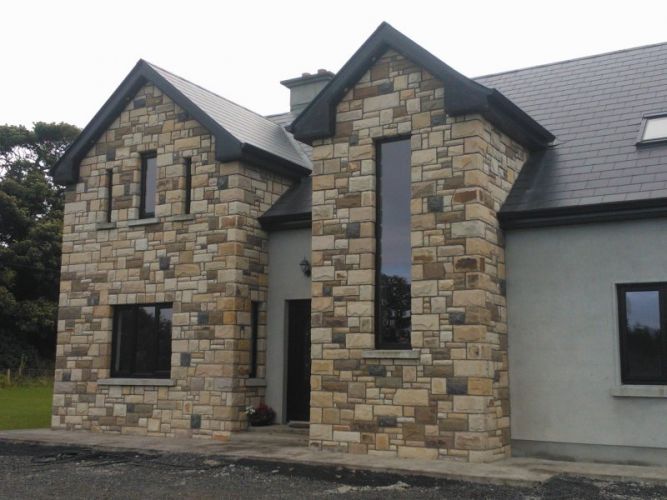Natural stone cladding
Natural stone cladding is the use of a thin layer of stone as a cladding for the outside of a structure. It is also sometimes used on internal surfaces. When applied properly, the thin layers achieve a textured and three-dimensional appearance, giving the impression that the structure is constructed entirely of natural stone.
Typically, stone cladding is used:
- To give a stone finish to an existing structure.
- To create a stone finish at lower weight, and so with reduced structural support requirements.
- To allow faster and lower cost installation.
- To allow modern the use of modern construction techniques and high-performance detailing, but with a traditional appearance.
- To allow off-site manufacturing, with reduced on-site construction.
- To reduce waste.
Stone cladding is manufactured by quarrying natural stone and milling it into thin pieces. A range of different sizes, thicknesses, shapes and patterns can be created according to the specification of the design. Cladding can be supplied either as single stone pieces, or as large, bespoke panels prefabricated form a number of pieces, such as storey-height panels or shaped parts such as reveals and lintels.
To accommodate the weight of natural stone, the cladding system should be fixed mechanically to structural substrate layers. This can be done using shelf angles or specially-made stone clips.
Alternatively, cladding panels can be made by laminating thin pieces of stone onto a carrier panel made from lightweight concrete. Because the two materials have similar physical characteristics, they work well together as a composite and provide good weather protection.
Where very thin stone pieces are used (around one inch thick), providing a final finish to a substrate such as blockwork, this may be described as a 'stone veneer'.
[edit] Related articles on Designing Buildings Wiki
- Ashlar.
- Brick.
- Brick veneer.
- Building fabric.
- Building with structural stone.
- Choosing stone.
- Cladding.
- Defects in stonework.
- Inspecting stone sample panels.
- Limestone for building.
- Masonry.
- Natural stone.
- Natural stone tiles.
- Patio stone.
- Pebbledash.
- Rustication.
- Stone dressing.
- Sustainable stone.
- Tufa and tuff
- Types of stone.
- Wall types.
Featured articles and news
Infrastructure that connect the physical and digital domains.
Harnessing robotics and AI in challenging environments
The key to nuclear decommissioning and fusion engineering.
BSRIA announces Lisa Ashworth as new CEO
Tasked with furthering BSRIA’s impressive growth ambitions.
Public buildings get half a million energy efficiency boost
£557 million to switch to cleaner heating and save on energy.
CIOB launches pre-election manifesto
Outlining potential future policies for the next government.
Grenfell Tower Inquiry announcement
Phase 2 hearings come to a close and the final report due in September.
Progress from Parts L, F and O: A whitepaper, one year on.
A replicated study to understand the opinion of practitioners.
ECA announces new president 2024
Electrical engineer and business leader Stuart Smith.
A distinct type of countryside that should be celebrated.
Should Part O be extended to existing buildings?
EAC brands heatwave adaptation a missed opportunity.
Definition of Statutory in workplace and facilities management
Established by IWFM, BESA, CIBSE and BSRIA.
Tackling the transition from traditional heating systems
59% lack the necessary information and confidence to switch.
The general election and the construction industry
As PM, Rishi Sunak announces July 4 date for an election.
Eco apprenticeships continue help grow green workforce
A year after being recognised at the King's coronation.
Permitted development rights for agricultural buildings
The changes coming into effect as of May 21, 2024.























Comments
A must read book for any civil engineer
STONE CLADDING ENGINEERING
https://www.springer.com/us/book/9789400768475